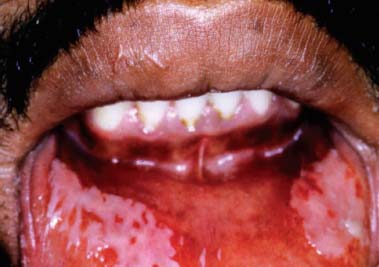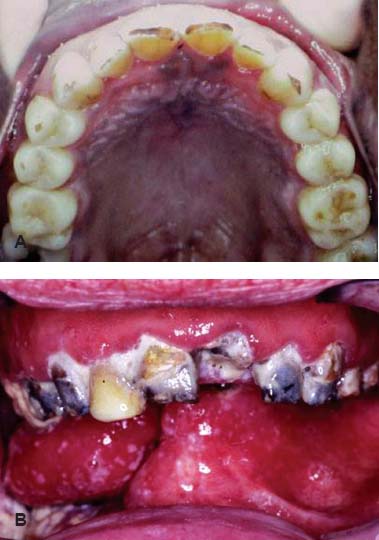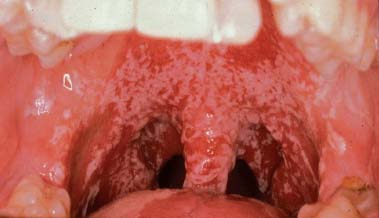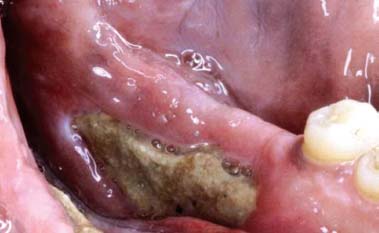26 Core Messages • Surgery, radiation therapy, and chemotherapy are common modalities used in the treatment of head and neck cancer. Combination therapy is required with advanced disease. • Each treatment modality has adverse side effects on normal oral tissues. • These side effects should be minimized for patient comfort, function, and overall health and quality of life. • Pretreatment oral evaluation is critical to manage acute oral conditions and to minimize acute and chronic side effects. • Management of oral side effects is important during and after treatment. • Management of oral conditions and prevention of oral complications is best provided by integrated multidisciplinary health care teams. Surgery, radiation therapy, and chemotherapy are common modalities used to treat head and neck cancer (HNC). Depending on the type, size, stage, and location of the tumor, it may be treated with single or multimodality therapy. The intensity of the side effects is usually less if these modalities are used concomitantly. Each type of treatment strives for a selective effect where there is a maximum therapeutic dose delivered to the tumor with minimal side effects to normal tissues. As these therapies have advanced, there have been more tumor-specific techniques and agents developed towards this end. However, unfavorable side effects still do occur and new side effects are being identified with new therapies. By minimizing and managing these effects, therapy may be made more effective and patient comfort, level of function, and overall quality of life will be improved and cost of care reduced.1 Radiation therapy may affect the oral mucosa (epithelial and connective tissues), salivary glands, muscles, blood vessels, lymphatics, nerves, teeth, and bones. Side effects include mucositis, hyposalivation, dental caries, changes in oral flora, infection, loss of taste, neuropathy, muscle fibrosis and trismus, and soft tissue and bone necrosis. Severity is not uniform or consistent but depends upon the surgery performed, radiation therapy (fields, fractionation, total dose), and individual patient variability. The introduction of intensity-modulated radiation therapy (IMRT) has decreased the severity of some side effects, but not eliminated them. Proper management dictates that all patients receive a comprehensive oral evaluation before commencement of cancer treatment, be monitored during therapy, and then be periodically followed for oral management once therapy has been completed. Oral management is best accomplished by experienced dental providers working as part of an oncology team. Some undesirable side effects of radiation and chemotherapy may improve once cancer treatment is complete while others linger on indefinitely and new, late complications may arise. Mucositis appears early and intensifies as treatment progresses. Within the first 2 weeks, erythema is noted followed by desquamation and ulceration as treatment proceeds (Fig. 26.1). Changes are caused by a direct effect of radiation on epithelial and connective components of the mucosa as well as a change in the oral flora that may result in a shift in oral bacterial and fungal colonization. In patients who continue to use tobacco or alcohol, who suffer comorbidities such as diabetes, or who undergo concomitant chemotherapy, these mucosal changes may be intensified in severity and extended in duration. In the most severe cases, treatment may have to be delayed, interrupted, or discontinued to allow the mucosa to recover. Once radiation therapy is completed, the mucosa will return to a clinically normal appearance over a period of a few weeks to months; however, vascular and neurologic changes and mucosal atrophy may persist. Although the skin is similarly sensitive, we see less severe changes because of “skin-sparing” sources of irradiation and improved techniques such as IMRT. Pain because of mucositis is a significant source of complaint for patients receiving HNC therapy. Oral prophylaxis may achieve a reduction in duration and severity of mucosal damage. Good oral hygiene, an atraumatic diet, and oral rinsing with saline are basic oral care recommendations. Food and Drug Administration–cleared devices for mucositis include coating agents such as sodium hyaluronate topical (Gelclair), mucoadhesive oral protectants (MuGard), and artificial saliva (Caphosol). Oral cooling with ice chips has been shown useful in short-acting, bolus chemotherapy, but not investigated in radiation therapy. Benzydamine (not available in the United States) has shown a preventive effect. Pain management should be provided as needed. Continuing studies provide reason for optimism for future advances in prevention and treatment of mucositis.2 After radiation of major salivary glands, reduced volume, increased viscosity, and changes in pH and inorganic and organic constituents of the saliva occur.3 Saliva becomes more viscous and sticky and decreases in amount, leading to xerostomia (Fig. 26.2A, B). Radiation causes vascular damage, loss of acinar cells, and may lead to fibrosis of the salivary glands. This may contribute to not only discomfort and intensified mucositis but also persisting changes and symptoms. Hyposalivation predisposes the patient to dental caries. It may also contribute to changes in taste, difficulty in swallowing, and the ability to wear a removable dental prosthesis as well as make the performance of routine oral hygiene tasks more difficult. Radiation-induced xerostomia may persist indefinitely. Patients may not report persisting dry mouth because of an acquired tolerance. Salivary changes after chemotherapy most often return to pretherapy baseline. After radiation therapy, there may be recovery of some acinar cells depending on the radiation dose and schedule.4 It is not likely that salivary gland tissue recovers from tumoricidal doses of radiation. The use of IMRT increases the potential for stimulation of residual function by reducing the volume of damage in the head and neck by sparing normal tissues. Lin et al5 have demonstrated the regeneration of salivary gland tissue in laboratory animals, but this has not yet been tried in humans. Minimizing exposure of the salivary glands and other critical anatomic structures is a goal of treatment planning. IMRT may have the effect of wider field/lower dose radiation exposure, which may result in increased responsiveness to systemic sialogogues if dry mouth persists. Amifostine is a salivary gland protector, indicated for use in patients with HNC receiving radiation therapy. Diagnosis of hyposalivation may be based on history and clinical observation. However, in persistent dry mouth, patients may accommodate over time and not report it while the conditions favor oral disease. Assessment of salivary flow is valuable in diagnosis and evaluating the response to treatment. Treatment of hyposalivation should focus first on stimulating residual function. Systemic agents may be used to achieve an increase in volume and salivary constituents and may be documented with sialography. There are several choleretic medications such as pilocarpine (Salagen) and cevimeline (Evoxac) that are approved for this indication. Bethanechol (Urecholine) has been studied off-label. Other approaches have included acupuncture and nerve stimulation. If salivary flow cannot be improved, there are numerous mouth-wetting agents to consider, and treatment trials to identify the most helpful product should be conducted. Jha et al6 have described a technique for surgically transplanting the submandibular salivary glands to remove them from the field of radiation. The advent of IMRT may limit further study of this approach. It is unclear whether radiation has a direct effect on the enamel, dentin, and cementum of teeth. There have been conflicting reports regarding the changes in these structures caused by radiation and whether their solubility is affected.7 It does appear that the dental pulp is significantly affected by tumoricidal doses of radiation. The vascular elements of the pulp fibrose and atrophy and sensory innervation may be affected. This may lead to an altered response to infection but may also decrease the degree of pulpal pain, even in the case of severe dental decay. An indirect effect on the dentition is decay secondary to hyposalivation, a change in saliva consistency and pH, and a decrease in the mineralizing constituents in the saliva. These carious lesions begin as demineralized sites on the teeth involving the incisal edges of teeth and at the gingival margins, especially interproximally, sites where decay is not usually seen. These lesions may progress to the extent that the entire crown of the tooth may be lost (Fig. 26.3A, B). Figure 26.3 (A) Incipient radiation-induced dental caries. (B) Severe radiation-induced dental caries. Changes in the oral flora are thought to be an indirect result of hyposalivation. An increase in cariogenic bacteria, such as Streptococcus mutans and Lactobacillus, predisposes to dental decay. A marked increase in the fungal population, most notably Candida albicans, may lead to an increase in oral infections. Underlying risk factors should be addressed, including diet history, oral hygiene, and dry mouth. Dental structures may be better maintained with regular fluoride applications such as a daily fluoride rinse (ACT), a high-potency fluoride dentifrice, fluoride gel in a custom carrier, and/or fluoride varnishes. There are no studies documenting the most effective means of fluoride application. In patients with dry mouth, calcium and phosphate supplementation should be provided and management of hyposalivation should be attempted. Antimicrobials for the treatment of a shift to cariogenic oral flora should also be considered. The oral environment, the tooth structure, and the bacterial component must all be addressed in addition to strict oral hygiene and diet instruction. Candidiasis is a frequent oral infection and increases during and persists after cancer therapy (Fig. 26.4). Risk factors should be addressed. Reduction of antibiotics, steroids, and hyposalivation-inducing medications should be considered. The care provider may choose between topical and systemic antifungals, depending on circumstances and preference. It should be recognized that nystatin (Mycostatin and Nystan) suspension is sucrose sweetened, and in a patient with dry mouth, it may increase the caries risk dramatically. Most patients who undergo radiation therapy experience a loss of taste. It is unclear whether this is due to a direct effect of the radiation on the taste buds or related to neural changes that affect them. In addition, salivary changes play a role, as loss of saliva may decrease both the number and the function of the remaining taste buds and limit the delivery of taste stimulants in solution to taste receptors. Loss of taste usually begins after the second week of therapy. In most cases, taste returns several weeks to months after the completion of therapy. In some cases, patients report a failure of taste to completely return, resulting in reduced or altered taste. This may be related to the total dose and ports of radiation. The loss of taste is significant aside from patient comfort. Patients report less desire to eat, and this may affect the body’s ability to take nourishment to repair the damage to normal tissues injured by the radiation. Patients who experience altered or loss of taste will need to experiment with alternative diet choices. It is unlikely that those with normal taste experience can make appropriate recommendations. Chronic taste alteration may be less common in those treated with IMRT. If dry mouth can be managed, it may assist in improving taste. Local oral, dental, and upper respiratory infection may affect taste and can be managed. Effective management of persisting taste changes is not well documented. Zinc supplementation has shown conflicting results in trials to date. Clonazepam (Klonopin) has been considered in some cases and has been shown to be helpful in altered olfactory sensation. Many patients who complain of an inability to masticate food because of loss of teeth or saliva are, in fact, compromised by a reduced ability to swallow. Radiation affecting the pharynx results in a loss of elasticity and fibrosis that may lead to narrowing of the pharynx and limitation of movement, thus complicating deglutition. Some surgical resections of tumors will involve the pterygoid space or the muscles of mastication. Muscle scarring as the result of wound healing may contribute to decreased oral opening. When the muscles of mastication are in the field of radiation, trismus or limitation of oral opening is a common side effect leading to disability. This is most often seen with tumors of the nasopharynx, soft palate, or parotid gland because of their location relative to these functional muscle groups. If the radiation is administered bilaterally or if in conjunction with surgery, the effects may be more severe. Radiation causes fibrosis or scarring of the muscle fibers, limiting their ability to stretch and function normally. The limitation of oral opening will affect patient comfort and the ability to eat. Trismus may also limit the ability to have preventative and restorative dental procedures performed including fabrication of an obturator to restore speech and feeding. It may also limit the patient’s ability to perform home hygiene procedures such as tooth brushing, dental flossing, and fluoride applications to the teeth. This may contribute to a rapid demise of the dentition. Once it has occurred, trismus is permanent and patients do not recover fully. The most effective course in management is to minimize its occurrence by initiating a physical therapy program at the start of radiation and to continue it for 3 months after radiation therapy is completed. The use of IMRT in HNC is associated with lower risk of trismus. Several mechanical devices have gained popularity in managing trismus. Therabite (Atos Medical, West Allis, Wisconsin, United States) and Dynasplint (Dynasplint Systems, Severna Park, Maryland, United States) are two of the most popular devices. A comprehensive, active home exercise program has also been shown to be effective. In any case, patient compliance seems to be the key factor in success. If trismus is severe or long-standing, a little permanent, significant improvement in the range of opening is expected. Tumoricidal radiation therapy has a significant effect on bone. Radiation-induced endarteritis causes a decrease in the size of the lumen of blood vessels and may cause total occlusion of fine vasculature within the bone. Bone that has been irradiated to tumoricidal doses may become acellular, avascular tissue, showing signs of fatty degeneration. The dynamic balance of osteoblastic and osteoclastic activity is interrupted and renders the bone a nonvital entity.8–10 The mandible is denser than the maxilla and has less vascularity, which may explain the increased risk of necrosis compared with the maxilla. High-speed radiation and IMRT have helped to diminish these changes in recent years, but postradiation osteonecrosis (ORN) remains a serious side effect of radiation therapy (Fig. 26.5). It is a nonhealing wound in nonvital bone. It is not primarily an infection of bone, although the lesion may become secondarily infected. Pain associated with ORN varies widely from none to severe, often related to the presence of any secondary infection or to the presence of a pathologic fracture. Injury to overlying soft tissue alone may not cause ORN, but may result in bone exposure. If the injury extends through to expose bone or if the mucosa necroses, osteoradionecrosis may develop. The effects of radiation on bone are thought to be permanent. However, angiogenesis and collateral circulation may improve blood flow in irradiated bone over time. Still, most clinicians approach the oral treatment of patients who have had radiation therapy with great caution. An insult to the bone is the most common precipitating factor in the development of ORN. Most often this is due to a dental extraction, but this may also be due to a periodontal or pulp infection, irritation from a removable dental prosthesis, or bone exposure may occur spontaneously followed by lack of healing of exposed bone. If a small sequestrum mobilizes sufficiently, it may be removed atraumatically. A more extensive surgical resection with bone reconstruction may be required for a larger necrotic area. Cronje described a protocal developed by Marx for the treatment of ORN that involves the use of hyperbaric oxygen (HBO) therapy and surgery. A controlled study of HBO alone did not show benefit in the recovery of ORN after radiation therapy. Many feel that surgical resection is an overly aggressive approach, but those who use it believe that it is the best way to treat the problem. Other approaches to management include the use of pentoxifylline (Trental) and vitamin E, which affect fibrosis and blood flow and reduce tumor necrosis factor in the tissue. Prevention is paramount. Dental care before cancer therapy, an ongoing preventive program, and close follow-up are critical to minimizing the risk of ORN.
Dental Oncology
Radiation Effects and Management
Mucositis
Salivary Gland
Teeth
Taste
Trismus
Bone
< div class='tao-gold-member'>
Dental Oncology301
Only gold members can continue reading. Log In or Register to continue

Full access? Get Clinical Tree







